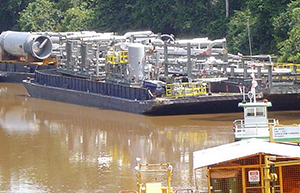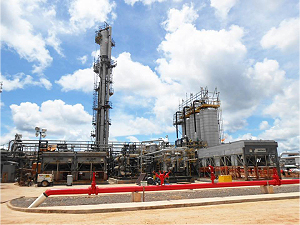

Contractors in charge of Petrobras’ fourth natural-gas processing unit in Brazil pulled off a feat of epic proportions: From a gas compound in Pojuca, the project team moved the unit through an intricate logistical operation that involved a 5,000-kilometer-long haul on roads and rivers through the Amazon rainforest.
Petrobras consultant Potencial Engenharia started, in late 2012, disassembling, conditioning, transferring, building and assembling the unit, called UPGN4, in addition to preparing the site at the oil company’s Urucu plant in the Amazon. Last month, the engineering company commissioned the $97.2-million project, called UPGN4, whose operation increases the local gas production to 6 million cu meters from 4.5 million cu m.
Pojuca is 3,000 km from Urucu as the crow flies, but natural barriers stood in the way. The set first had to travel over 2,000 km of roads from Pojuca to Belém using special-cargo trucks. Next, the disassembled pieces rode on barges up the Amazon River.
Next came the most challenging leg of the trip: traveling down one of the most winding rivers in the world, the Urucu, a tributary to the Amazon river, as far as Port Evandro in Província Petrolífera de Urucu, in the municipality of Coari.
The Urucu River
Among the pieces of carried equipment were a molecular sieve, tower, skid, kiln, electrical plant and several tubes. To be able to put together a logistics schedule, engineers had to observe and chart the navigable conditions of the Urucu River.
“The river either is dry or it overflows, depending on the period, and that has to be very well observed,” explains Roberto Bernardes, engineer and contract manager with Potencial Engenharia.
At Porto Evandro in Urucu, it was still necessary to carry components on special vehicles for approximately 50 km to the assembly site at Polo Arara, inside Província Petrolífera. Assembly workers arrived on commercial airplanes that landed at the airport that services Petrobras’ base in Urucu. Part of the team involved in the project was lodged on a specially prepared boat.
For the transfer to take place with fewer risks and interferences, Potencial's engineers did a 3D laser scanning of the unit when it was still assembled and transposed it virtually to the Urucu plant.
“It was of the essence for us to see the conditions under which the work would be implemented,” says Bernardes. According to the engineer, the unit had to be put back together exactly as it had been originally assembled, which made the 3D technology an important ally in that task.

Post a comment to this article
Report Abusive Comment